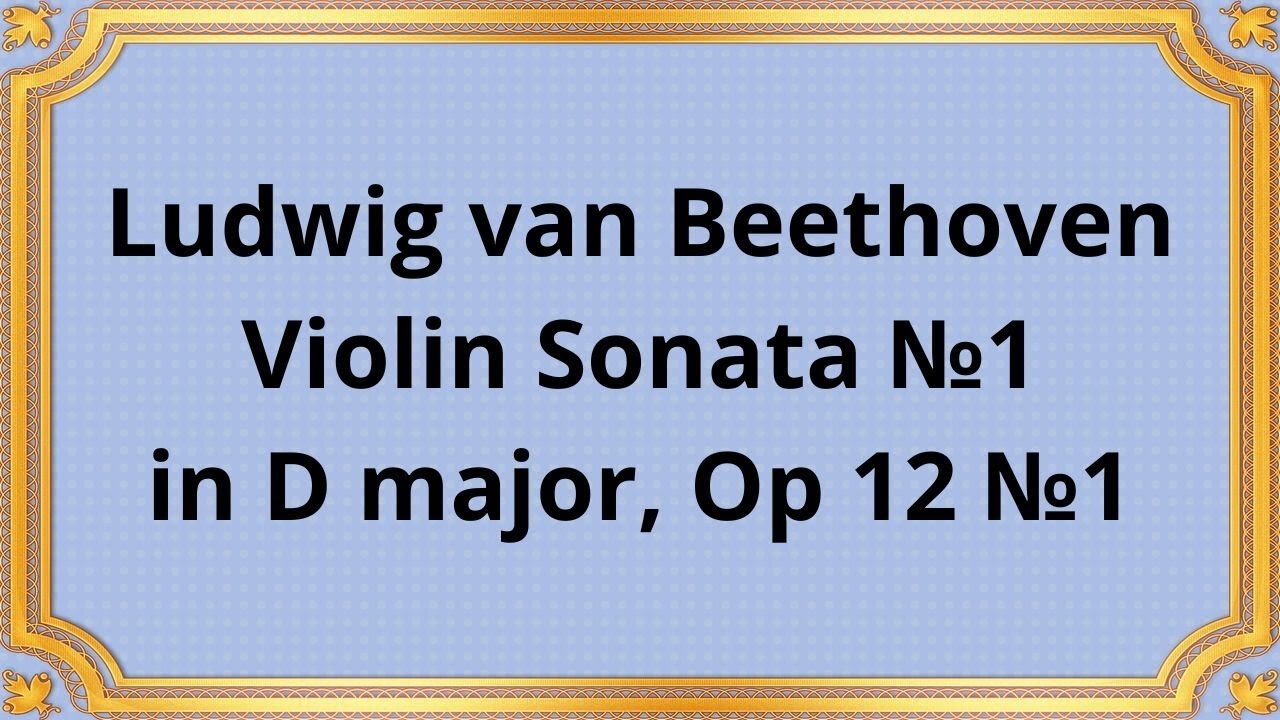Premium Only Content

Ludwig van Beethoven Violin Sonata №1 in D major, Op 12 №1
#Beethoven #ClassicalMusic #ViolinSonata #DMajor #Op12No1 #MusicAppreciation #SonataForm #MusicHistory #Composer #RomanticEra
Wolfgang Schneiderhan, Wilhelm Kempff
Ludwig van Beethoven, a prominent figure in classical music, left an indelible mark on the world of composition. Among his vast musical repertoire, the Violin Sonata No. 1 in D Major, Op 12 No. 1, shines as a testament to his artistic brilliance.
Beethoven composed the Violin Sonata No. 1 in D Major, Op 12 No. 1, during the late 18th century, a time of transition from the Classical era to the Romantic period. This sonata, written around 1798-1799, showcases Beethoven's departure from the traditional classical style and hints at the innovative and expressive qualities that would define his later works.
The Violin Sonata No. 1 follows the traditional three-movement structure commonly found in sonatas of the time. The first movement, marked Allegro con brio, introduces a lively and spirited theme that immediately captures the listener's attention. The second movement, marked Tema con variazioni, presents a theme followed by a series of variations, showcasing Beethoven's mastery of musical development. The final movement, marked Rondo: Allegro, concludes the sonata with a joyful and energetic character.
Beethoven's Violin Sonata No. 1 exhibits several expressive elements and innovations that distinguish it from the works of his predecessors. The composition showcases Beethoven's ability to evoke a wide range of emotions, from exuberance to introspection. It features dynamic contrasts, sudden shifts in mood, and intricate melodic lines, all of which contribute to its captivating and expressive nature. Beethoven's use of unexpected harmonic progressions and rhythmic complexities further adds to the sonata's unique character.
The Violin Sonata No. 1 highlights the collaborative nature between the violin and piano. Beethoven gives equal importance to both instruments, allowing them to engage in a musical dialogue throughout the piece. The violin and piano intertwine their melodies, harmonies, and rhythms, creating a harmonious and balanced musical conversation.
Beethoven's Violin Sonata No. 1 in D Major, Op 12 No. 1, continues to captivate audiences with its timeless beauty and artistic depth. Its expressive qualities and innovative elements have made it a cherished gem of the violin and piano repertoire. The sonata's enduring appeal lies in its ability to evoke a wide range of emotions, leaving a lasting impression on all who experience it.
Conclusion:
Ludwig van Beethoven's Violin Sonata No. 1 in D Major, Op 12 No. 1, stands as a testament to the composer's artistic brilliance and his profound impact on classical music. Its innovative structure, expressive elements, and collaborative nature make it a treasured piece of the violin and piano repertoire. This composition continues to inspire and move audiences, reminding us of Beethoven's unparalleled contributions to the world of music.
You have the opportunity to support the channel:
https://destream.net/live/RadSiarAl/donate
https://www.buymeacoffee.com/6355radsiaral
-
 LIVE
LIVE
Akademiks
6 hours agoJay Z says he aint NEVER been friends w/ DIDDY! Bhad Bhabie lost her man? Travis Hunter Down Bad?
3,991 watching -
 2:27:04
2:27:04
AirCondaTv Gaming
5 hours ago $0.58 earnedWar Thunder - Tankering Around for That 10 Bomb
32K4 -
 4:19:05
4:19:05
SpartakusLIVE
7 hours agoThe MACHINE locks in for 12-hour POWER stream
23.3K1 -
 1:58:40
1:58:40
Robert Gouveia
6 hours agoJ6 Coverup: Prosecute LIZ CHENEY; NY Judge REJECTS Immunity; Trump Breaks Gag?
103K65 -
 2:22:06
2:22:06
WeAreChange
5 hours agoPSYOP Spreads: Drones Shut Down Airport In New York!
70.4K39 -
 1:31:18
1:31:18
Redacted News
7 hours agoEMERGENCY! NATO AND CIA ASSASSINATE TOP RUSSIAN GENERAL, PUTIN VOWS IMMEDIATE RETALIATION | Redacted
213K368 -
 56:45
56:45
VSiNLive
6 hours ago $5.09 earnedFollow the Money with Mitch Moss & Pauly Howard | Hour 1
68.1K2 -
 52:44
52:44
Candace Show Podcast
7 hours agoMy Conversation with Only Fans Model Lilly Phillips | Candace Ep 122
86K270 -
 LIVE
LIVE
tacetmort3m
7 hours ago🔴 LIVE - RELIC HUNTING CONTINUES - INDIANA JONES AND THE GREAT CIRCLE - PART 5
197 watching -
 26:52
26:52
Silver Dragons
5 hours agoCoin Appraisal GONE WRONG - Can I Finally Fool the Coin Experts?
32.6K2